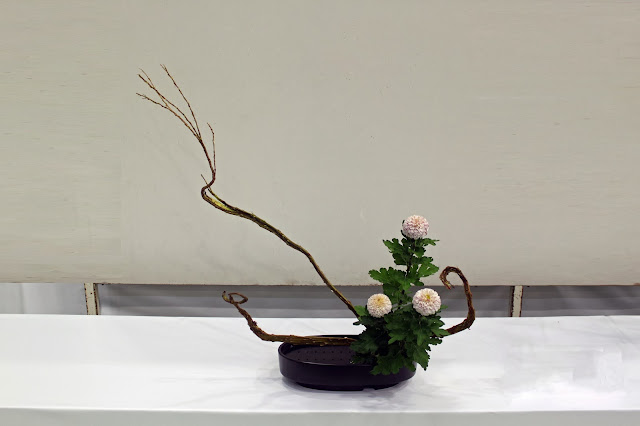This year, one of my more advanced students participated in the festival. She wanted to do a One-Row arrangement using dark colored calla lilies. I asked the flower shop to try and order some lilies, and they ended up having to get them shipped in from Tokyo! This was her second time to do an arrangement for the culture festival, but it was her first time to do a large arrangement like the one she did. She made a beautiful arrangement and should be very proud of herself!
One-Row Form
Calla lily, carnation, spray carnation, solidago, Homalomena
The other student who participated in the festival for the first time has been doing ikebana for a while, but is still in the beginning stage. She wanted to use some type of branch in the Inclining Form. We went to the flower shop together and found some beautiful "Sekka" willow which would be perfect the type of arrangement she wanted to do. She did a wonderful job and should also be proud of herself!
Inclining Form
Fasciated willow "Sekka", ping-pong chrysanthemum
As for me, I wanted to do something more with a Japanese fell to it, something a little larger in a vase. I wanted to try to do a Bunjin arrangement, a type of ikebana based on a Japanese interpretation of the Chinese bunjin, or literati. Emphasis is placed on the elegance and poetic nature or rare blooms, shrubs, and plants. It is not bound by any specific floral style, and materials may be freely arranged to express the unique beauty of each stem, flower, or leaf.
A friend lent me a beautiful vase that would be perfect for this type of arrangement, so I was ready to go, but I couldn't decide what materials I wanted to use. I thought I would like to use pine and some type of tropical flower along with something bold to place in the front of the arrangement to give it balance. My teacher had a beautiful hydrangea blossom that had partially dried on the bush (it was at least 10 inches across!), and another student had a beautiful branch of aged pine that she let me use. I went to the flower shop and got my tropical materials, and voila! I had my arrangement. All of the materials are arranged as if they are the star of the show, but there is a balance between all of the materials.
Bunjin Arrangement
Dried hydrangea, pine, heliconia
The festival was held for three days and many people came to enjoy all of the different works displayed. I had a great time, and my students did, too! One of them is already looking forward to next year's festival!
This coming weekend, I have another exhibition to prepare for, this one the prefectural fall ikebana exhibit. I have some great materials I found a couple of weeks ago and can't wait to create it and share it with all of you. Look for part 2 soon!
As always, fell free to comment below. Let me know what you think of the arrangements or tell me about your favorite fall flowers. Also feel free to share or +1 it!




2 comments:
I can understand why you are proud of your student’s works, they are lovely. I really like the materials they selected and their arrangements. Using white containers for the One Row really makes the dark colors of the materials jump out at you. I like the expressive fasciated willow branches your other student used for her arrangement. How nice that you went to the floral shops with your students, they are lucky and I’m sure grateful to have you as their teacher.
Gail,
Thank you for the wonderful comment! You're right, the white container does make the dark color of the materials pop. It has a very chic and modern look to it, I think. It was fun going to the flower shop with the students and helping them choose their materials. Trying to decide what color combinations to use and what flowers or materials to combine is a good exercise for my students. I think I am lucky to have such great students!
Stephen
Post a Comment